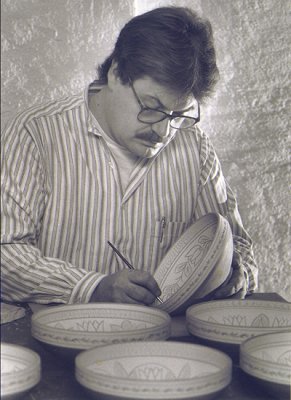Master Potter Hans Törngren started Törngrens
Krukmakeri in Falkenberg in 1789 and from that day pottery-making
has continued in the same workshop and within the same family,
passing from father to son. Bengt Törngren who currently runs the
workshop is the 7th generation.
 |
|
During the latter part of the 18th century and all of the
19th a thriving pottery industry flourished in Falkenberg. It
has been 21 different potterys in town. Today only Törngrens
remains from those times.
The productions in these workshops was mainly domistic ware such
as storage jars, plates and bowls but "kakelugnar" (ceramic
fireplaces) were also produced up until the early 1900`s when
more modern forms of heating replaced them. |
The methods of decoration used in Falkenbergs pottery were
sometimes simple "sliptrailing"used a goose-quill pen or an animal
horn to trail a pattern of white liquid clay (slip) on to the
red-brown clay of the pot and other times "sgraffito" or "painting"
where the whole red earthenware item was dipped in white slip and
decoration scratched into or painted onto the surface.
On top of these patterns was applied a transparent glaze. The latter
design methods were predominant in Falkenberg and can be traced from
Holland via Germany, Denmark and upp to Tröndelag in Norway, helped
no doubt, by the wanderings of newly qualified potters who travelled
extensivly during the 18th and 19th century in order to gain
experience.
The traditional pattern was based on a flower, usually the tulip or
flax, but each potter developed his own variations on this theme.
This type of decor has therefore not been "invented" by any person
but has developed out of over 200 years of tradition.
Törngrens still work with this traditional production whitch also
means that the hold to the simple, time-honoured shapes that suit
the decoration so well.
Törngrens Krukmakeri have still their own decorative patterns
"TÖRNGRENS-MÖNSTRET" designed by Hans Törngren 1789 the man who
started Törngrens Pottery.
Traditionally, Törngrens also produce clay Cuckoo.whisles. These
were originally made by the companies apprentices and sold to
supplement their meagre income before they qualified as potters.
A special drinking-vessel "GYCKELKRUS", (the Jesters Jug) came into
production in the mid 1800´s. This is made in such a way that it
requires a special technique to drink from it!
|